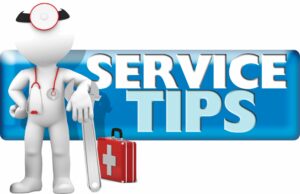Written on: March 1, 2013 by Wayne Lawrence
 Hello again! Having fun this winter? I must admit I am not! With March now here, we’ll soon get a chance to make good on all of our “…make this up to our family promises” we made as this season’s cold kept us away from home much longer than we’d have liked.
Hello again! Having fun this winter? I must admit I am not! With March now here, we’ll soon get a chance to make good on all of our “…make this up to our family promises” we made as this season’s cold kept us away from home much longer than we’d have liked.
This industry has changed over the years, and now, in addition to providing great customer service and exceptional troubleshooting skills, we also need to have great salesmanship—which means bringing in billable revenue! With that in mind, as this winter of extreme overtime winds down, here are a few things I look for when on a service call:
1) Oil tanks and oil lines
Age and condition of tank and lines. I take a proactive versus a reactive stance when discussing a customer’s oil tank, and I try to make them aware of avoiding a potential future hazard. If I happen to sell them on a new tank, there’s a good chance they’ll stay with our fuel source. Also, any copper oil lines in direct contact with concrete are quoted for replacement with coated line.
2) Energy management controls
Customers are very interested in energy savings these days. There are quite a few controls currently on the market that feature outdoor reset. Some even have wireless sensors. I must admit I’d rather install these controls than digital thermostats, but that’s mainly due to all the nuisance reprogramming, battery change and time change calls I go on each year that I can’t charge for!
3) Whole house surge suppression.
Since we’re already in the utility room; it only takes a few seconds to look at the electric service panel. If we sell them a microprocessor management control, we need to protect it in case of an electrical spike. It will be tough to explain after a thunderstorm that the newly installed control system you just installed is now not covered due to storm damage!
4) Water main
Is there a pressure reducing valve on the main? A backflow preventer? Any complaint of water hammer on the domestic side of the system? If so, a domestic expansion tank, charged to meet the incoming water pressure, should be suggested and quoted.
5) Anode rods
Is there a direct-fired water heater? Was the anode ever changed? I keep the fourlink replacements on my van. If it’s a 30 gallon heater, I just cut one link off. I keep an impact ¾” drive socket with a breaker bar on board with a ¾” NPT tap, just in case. If they go for the replacement, I’ll get it out. However, I know not to attempt replacement on a heater in poor condition!
6) Indirect water heaters
Any calls for insufficient water duration? The coil may be dirty! A tank cleaning/ tank flush service will be quoted. If you happen to sell them on the tank cleaning, a check of the aquastat well is suggested, as there is no anode on some indirect water heaters, and you wouldn’t want a well leak causing water damage after completing service on the heater. I also add in the price to replace the T+P relief valve.
7) Mixing valves
Is there one on the tankless coil? Is it a manual or thermostatic valve? Do they get sufficient hot water duration from their indirect water heater? If not, adding a thermostatic mixing valve and raising the indirect’s temperature usually cures most complaints. I go over these things with the customer. The lack of a mixing valve is a scald hazard, and against code.
8) Coil gaskets
The leakers will start to show up soon! Don’t forget to add for the extra labor to drill and tap the broken bolts encountered during replacement! UGH! A tip to those doing coil gaskets: use Permatex Anti-Seize!* One bottle of this lubricant will last you years, it withstands 2000 degrees, and for all future repairs, the bolts come right out. I use it on all new installations: circulator bolts, coil bolts, smoke hood nuts, burner flange bolts.
9) Washing machine hoses
I’m amazed how many customers fail to check the condition of the washing machine hose. You’ll see the rubber bulging at the crimp connection. Lots of horror stories heard over the years from burst hoses and flooded basements.
10) Heating equipment upgrades
I put this last because this is, at times, tricky. It seems that when suggesting an equipment upgrade, a mention of switching to an alternate fuel source comes into the conversation by most customers these days! I would suggest being able to explain the vast difference between “steady state” and “AFUE” efficiency, and to make the customer fully aware of the much shorter run times achieved with the newer equipment. It’s a good idea to direct them to the online energy savings calculators they can use while making their decision. Well, that’s it for now, as a fun-filled, 18 degree night shift awaits me! Be proud of what you do! Stay safe!
Wayne
*Or an equivalent product. There are other anti-seize products on the market, including ones from Loctite, Anti-Seize Technology and LPS, to name a few. – Ed.